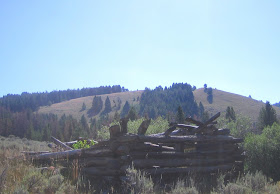Taking up a position on a bluff above a small creek, just where the creek breaks out of the timber and flows through a broad willow bottom, I tried out my moose calling skills: "Here moose, here moose!" Actually, you kind of grunt and groan into a rolled up cone of cardboard. Right off, a cow & calf elk jumped up from their bed in the willows, took one look at MollyTheDog & I, and beat a hasty retreat back into the brush. These two buck pronghorn antelope, on the other hand, came in at a dead run from nearly a mile away, halting about 200 yards out:
Maybe I need to polish my moose calling skills. Hiking upstream along the grassy meadows along the creek, I began to find moose sign. Well, sometimes you get the moose.... And sometimes you get the moose dung:
Now, this is encouraging. A shed moose antler, on its way to being recycled by gnawing squirrels, mice, and porcupines:
Hmmm.... Maybe I need a decoy? MollyTheDog, one shed antler, and a roll of duct-tape (MTD is thinking this is NOT a good idea):
No moose this morning, but there are some flowers about. Monkeyflowers, both Lewis's (Mimulus lewisii) and Yellow (M. guttatus) growing along the stream:
And a favorite of mine, Fringed Grass-of-Parnassus (Parnassia fimbriata), named after Apollo's mountain where the Muses frolicked. Do you think these are the Muses on the flowers? Kind of creepy looking Muses, I'd say:
No moose perhaps, but maybe there's a buffalo around. Lots of Buffaloberry (Shepherdia canadensis) at any rate. By the way, they look a lot nicer than they taste, although Indians whipped them with water and ate the froathy treat:
Today, you could spend weeks in this area of the Pintler Mountain Range/Beaverhead National Forest and never see a soul. A century or so ago, however, it was a hopping place, buzzing with placer miners and loggers. You can hardly take a step, it seems, without tripping over some old cabin. Some are right along the road:
Some are rotting back into the soil beneath the trees:
And others are in little prairie opening in remote places far from any current road:
Time to head home & quaff a pint at the Quarry Brewpub.












Nice pics, and an antelope would be a good consolation prize.
ReplyDeleteWhen I lived in Alaska 35 years ago, I hunted moose only once, tho I shot caribou a couple times. I drove down the Kenai peninsula to Quartz creek, four-wheeled a mile or so till the road petered out, then hiked 4 miles or so up the narrow valley. I saw a smallish bull, maybe 500 lbs, sighted the .338 at him, simple shot, then thought....how am I going to get him out? Hike back out, went home and sulked.
Well you captured some beautiful photos anyway. Maine has a moose lottery now, something new in the past five years or so. I usually see about one a year down here in our area, but lots when we go up in woods near the Canadian border.
ReplyDeleteThe Buffalo berry looks like our winterberry. I have never tasted it, but the birds love them.
I love that cabin that is on its way out.
ReplyDeleteMTD looks nervous!
ReplyDeleteFunny that you called in curious antelope and scared off the moose! Poor MTD, I'm sure she'd rather not dress up in antlers!
ReplyDeleteInteresting to think that your mountains were more populated a hundred years ago. The same may have been true here. We do see a lot of abandoned cabins in the mountains.